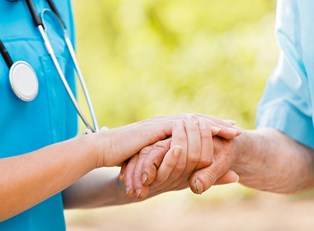Shingles (herpes zoster; zoster; or zona) is a painful, blistering skin rash, most commonly appearing as a band or stripe on one side of the body. The rash evolves into clusters of blisters, which fill with fluid, and finally, within seven to ten days, the blisters crust over. Eventually, the crusts slough off, and the skin heals.
It is caused by the same virus that causes chickenpox, which doesn't go away but lies dormant in the nerve roots after recovery. When disease, stress, or aging weakens the immune system, the virus becomes active again,causing shingles signs and symptoms. Anyone who has had chickenpox is susceptible to shingles. Because it is a virus, shingles is incurable, though most individuals who suffer the illness only experience it once, without recurrence, and fully recover.
Shingles treatment attempts to help minimize the pain, shorten the duration of a breakout, and reduce or eliminate complications. Earlier self-diagnoses of shingles leads to earlier treatment by a physician. Shingles usually clears within 2-3 weeks. Those who experience continued dizziness, weakness, extended pain or rash on the face, changes in vision, confusion, or a rash that continues to spread should seek help from his or her primary physician immediately.
Shingles Signs
First, one should consider the likelihood of contracting shingles based on health history and circumstance. One must have had chickenpox in order for it to be possible to get shingles. Those most at risk of developing shingles are adults aged 60 or older, individuals with weakened immune systems caused by conditions such as HIV/AIDS, cancer or cancer treatments, prolonged used of steroids, and drugs designed to prevent the rejection of transplanted organs. Still, it must be considered that half of those who live to the age of 85 will get the disease and require shingles treatment.
The earliest signs of a coming shingles outbreak are fairly general and may be mistakenly disregarded, attributed to another cause, or misdiagnosed as a different illness. At first, one may experience migraine-like shingles symptoms, including headaches and sensitivity to light. One may feel tired, weak, much like he or she has the flu but without a fever. Next, an itching, tingling, or pain in a specific area of the skin will occur. This is where a band, strip, or small rash may develop. If the rash begins to blister, one should contact a physician to get diagnosed and begin shingles treatment as soon as possible.
Shingles Diagnosis
Some people have such mild shingles signs and symptoms that they don't seek medical treatment. Others have such a severe outbreak, it sends them to the emergency room. Therefore, it is important to listen to your body. When one suspects an illness, such as shingles, one may begin to write down a detailed description of the shingles symptoms. Always have personal information about medical problems and health history handy but in a safe place, as it can greatly increase the accuracy of a diagnosis. Make a list of all of the medications and dietary supplements one takes, because they can often cause skin reactions due to allergens rather than viruses.
A doctor will examine the shingles rash and ask questions about general health and when the symptoms began. Shingles diagnosis is usually based on the pain on one side of the body, along with the telltale rash and blisters. Some physicians may take a tissue scraping or culture of the blisters for further examination in the laboratory. Taking note of these early signs of shingles and seeking early diagnosis can go a long way toward helping a quick recovery and avoiding serious complication.



